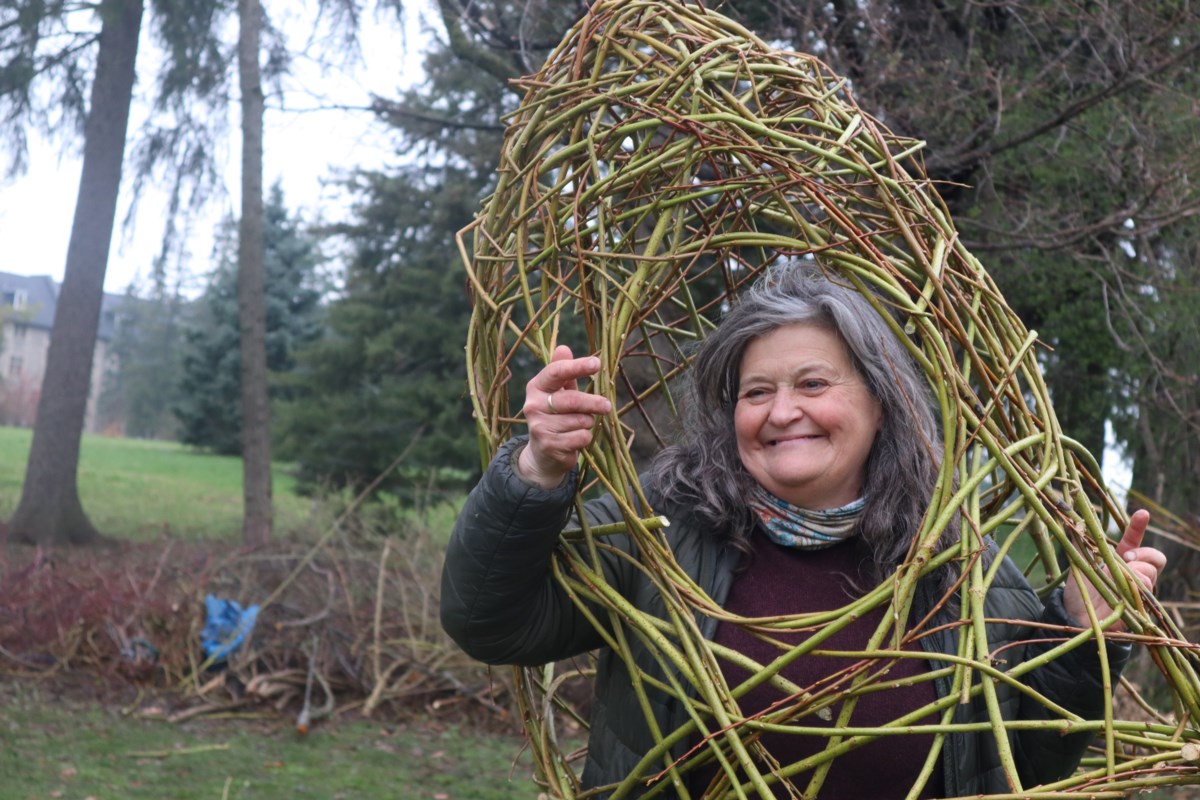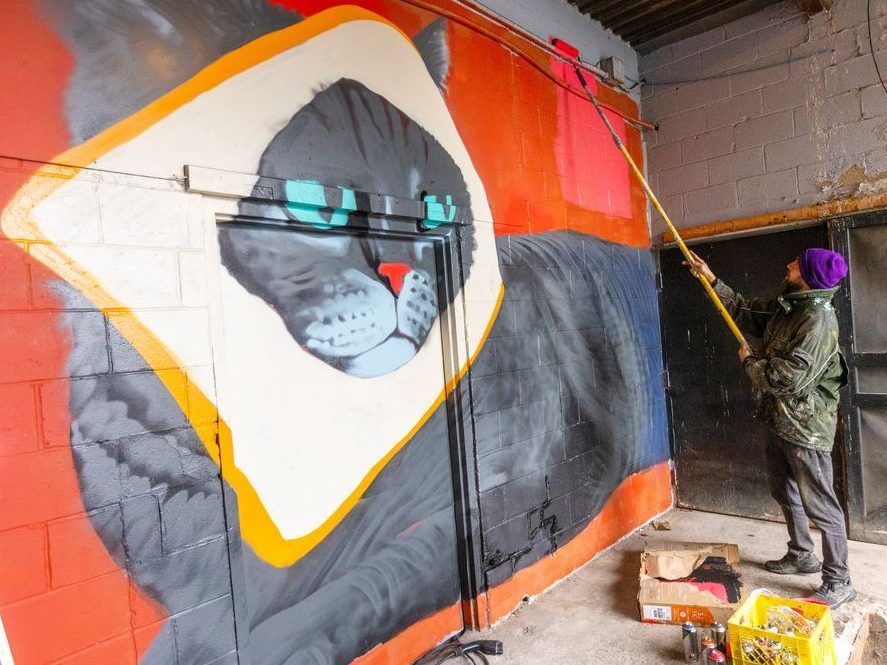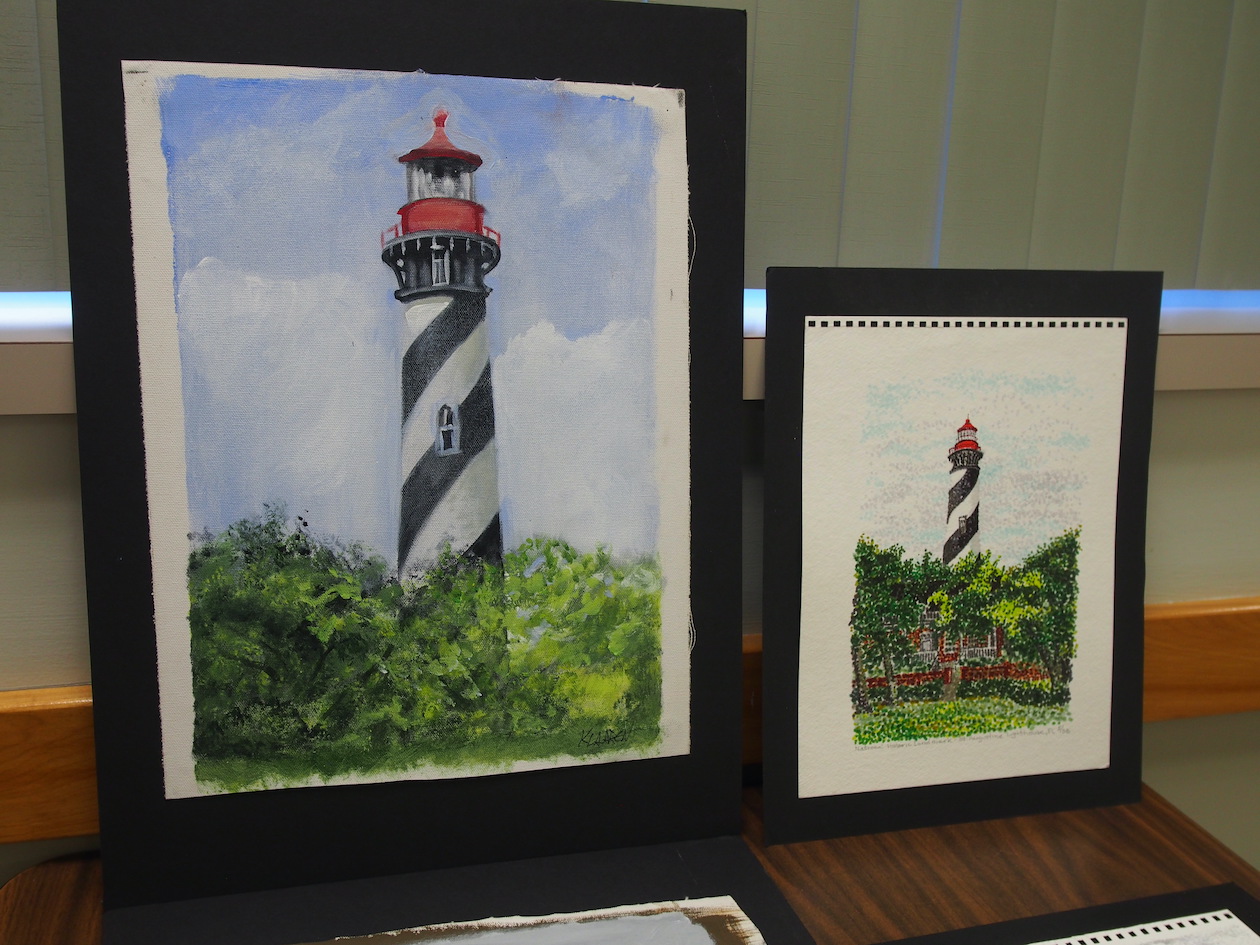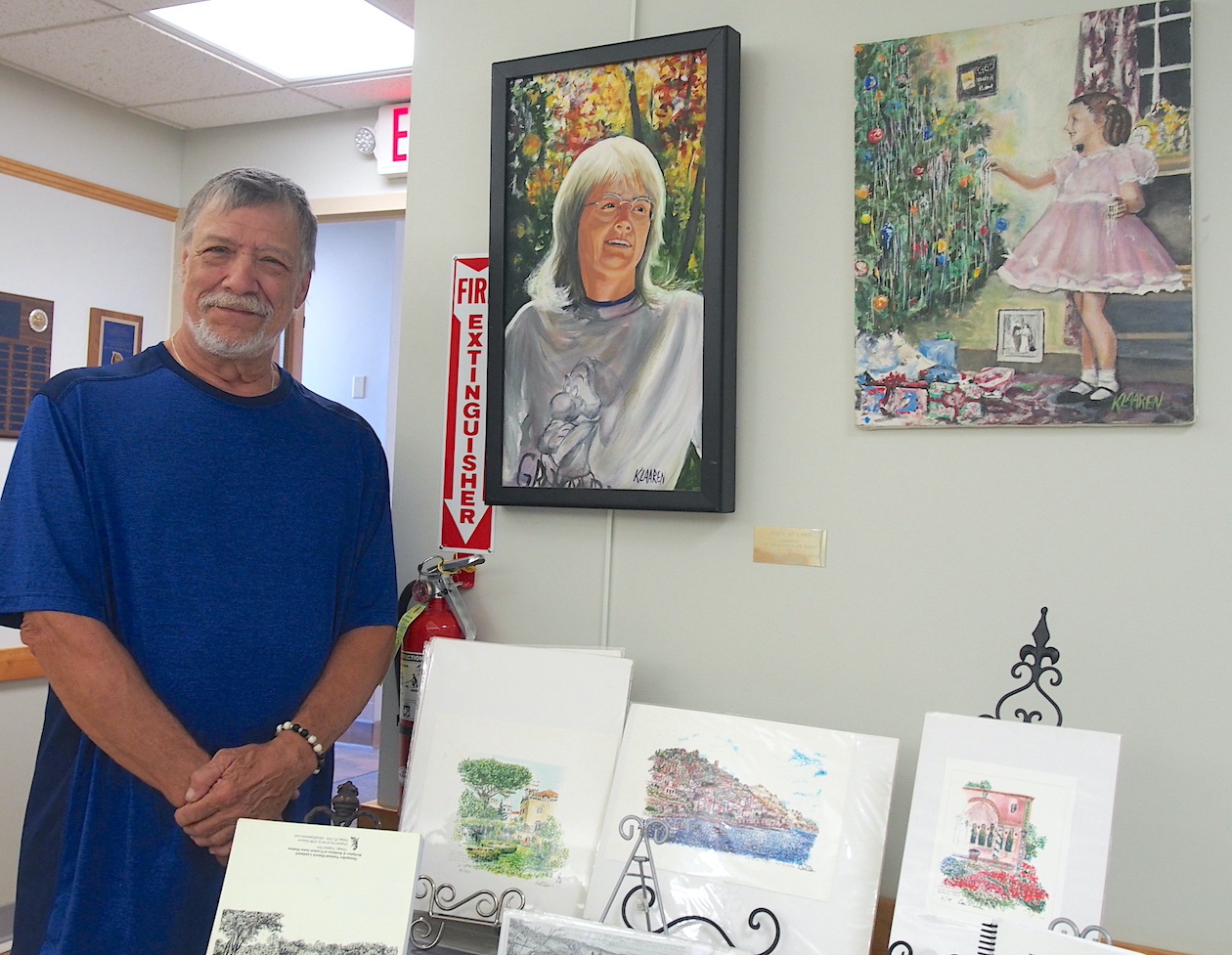Art
Remembering Dori Klaaren and her art – Niagara Frontier Publications
Sat, Aug 13th 2022 07:00 am
Story and photos by Alice Gerard
Terry and Dori Klaaren were exploring Morocco after having traveled through Europe for approximately eight months. They were a young couple in the early 1970s, and Dori had suggested the trip, explaining that it would be a good time to do it “ ‘Because we’re free; because we’ve got no careers. We have no kids, no debts. We will never be this free again for the rest of our lives. We need to travel,’ ” Terry said to a group at the Grand Island Memorial Library, where he spoke about Dori’s artwork on Aug. 1.
The couple met in Grand Island High School in 1969, where they both took art classes and belonged to the art club. Dori had grown up on Grand Island, and Terry moved there as a high school student.
“I landed on Grand Island. Everyone was happy. I felt at home, and I started dating. I had three girlfriends before I met Dori, and that was the end of my dating career,” Terry recalled.
Morocco was a different world altogether for the couple who had married in 1973.
“It was a cultural jump to go to Europe in the first place,” Terry said. “We took six to eight months doing it. Our last stop was Morocco. We wanted to jump down and go to Africa. We were told not to stay in Tangier, but to go to the interior and see the real Morocco. We hitched a ride with a man from Australia, who just wanted to drive around.
“We went into a place one day in the Atlas Mountains. We’re in a big field surrounded by these tents and there’s all these kinds of horses. They have muskets. They charge down the field and shoot off their guns. It’s this celebration. We’re walking around, the three of us. We get to this big tent full of pillows and these guys invite us in. We’re just kind of gesturing. We had the tea, and we were going to say thank you, so we said that. We were about to leave, and he poses for a picture and says something, and the other man says, ‘He wants to buy your wife.’ He offered camels for her. I don’t think so. It really happened.”
Terry described the entire European adventure as being life-changing for both Dori and him.
“We were there for a year,” he said. “We rode on bicycles. We hitchhiked. We took a couple of trains that we couldn’t afford, but we were there for the better part of the year, from Norway to Morocco. We camped in people’s yards. We camped everywhere, stayed in the occasional hotel. We went to Stonehenge on the Solstice. She planned all this, so it happened. We came back from Europe alive and happy. Dori carried a 45-pound backpack, bicycled every mile.
“We came back young, strong and confident. So, we went back to Grand Island and lived with her folks for about a year. I worked downtown at LL Berger as a window dresser. She worked for the PennySaver, right here, for Skip Mazenauer. With our new nest egg, we went back to Florida and created a child. He is 42 years old now. He is Jason, and he’s great.”
Terry and Dori Klaaren both painted a lighthouse in their own styles.
••••••••
Back in Florida, Terry and Dori found a new way to create art.
“We get into carrousel horse painting,” he said. We had friends who bought full carrousels, restored them, and put them into malls. They hired us to paint the horses. After a while, we got good at it. I was a wood carver, so we went on our own. We went to auctions, and we’d get commissions from people. We’d fix up the horses. We did that for some years. We weren’t making much money, but we loved the work.
“This job got me the opportunity to work in Orlando for a prop shop to paint a big, fake carrousel horse. I see that they’re working on Disney projects. There’s a paint shop. So, I got a job there. Very interesting work. I learned my chops. I learned how to paint big.”
At the same time, however, Dori lost her work opportunities. Terry explained, “She was a calligrapher and a sign painter and a graphic artist and a freelancer for ad agencies. It all went to computers. She said, ‘I’m dead in the water. I have no work.’
“I was in Orlando, with Disney in my portfolio. I want to paint murals. So, she became my agent. Within a year, we tripled our income. Suddenly, I was in hot demand. We got into our business, and we started doing murals and paintings, and she was my manager, the quartermaster, the brains behind the artist. At this point, her art disappeared from the picture. We were being very successful in the mural business. I made a lot of money, but didn’t spend much.
“We were told that we had to spend a lot of money on our business or we’d have to return it in the form of taxes. So, she developed ‘have brush, must travel.’ She planned a trip that would last six to eight weeks, either in Europe or out west in national parks, and then she’d tell my clients, ‘If you’d like a painting done on site anywhere you want, the commission is $200, and he’ll make this painting for you.’ We got a dozen or so commissions, and we went out and did the trip. This is what we spent 20 years doing. It was fun. I’d paint the painting that was commissioned.’
“My painting started to change. Essentially, I was doing acrylics. Dori started off not knowing what to do. She wasn’t a painter. She was a textile person. I suggested that she paint like doing embroidery by doing dots. She was trying to figure out her style. You’ll notice that it changed and got better and better until she made magnificent pieces with nothing but beautiful dots. Then she developed an essential tremor, and she could no longer control her dots. It took her way too long to finish her paintings. There are unfinished paintings, where she just ran out of steam. I suggested that she change her format and just do black and white. This is a woman who was working with a tremor. She could barely write her name, but she could produce artwork. I am here to show you all the things that Dori never got to be known for.”
During the presentation, Terry acknowledged three teachers, who were influences on both Dori and him. They were Lyn Laman, who died May 31, 2019 (three months after Dori); Neil Hoffman, who now lives and works out west; and Lenore Tetkowski, who was in the audience.
“Nothing here is for sale. However, these are reproductions of her work, and they are up for donations. I am going to garner anything that I make from her work and use it for an art incentive award for the high school. No prices. Just donations,” Terry said.
“I ended up by having a beautiful life, doing exactly what I wanted to do,” he added. “I’d never dreamed of being an artist for a living. It never occurred to me. It was always fun. Work was supposed to be not fun. So, the fact that this all happened, and I’m looking back on it now, is a miracle to me. The downside is that I lost her too soon. But we had almost to the day 50 years together.
“We went to see Mount Saint Helens 30 years after the fact, and we hiked for 15 miles into that barren place with nothing but dead trees. We hiked up to the top of that ridge and got the shot of the mountain, the volcano.
“We had 50 of the best years. I lost her too soon, but we had a concentrated 50 years.”
Terry Klaaren, with a painting of his late wife, Dori, who died in 2019.
Art
Collaborative art project highlights the artistic and healing properties of trees – GuelphToday


Combining nature, art and science came to fruition with a collaborative stick weaving project today.
At the How To Draw A Tree Wellness Circle on Johnston Green at the University of Guelph, people were welcomed to join artists Dawn Matheson and Agnes Niewiadomski to create a sculpture made out of sticks.
Trees saved Matheson’s life. She has her own challenges with mental health but being with trees in nature relaxes her and calms her mind.
“It’s just a practice I’ve developed. It grounds me,” she said.
She wanted to bring a bit about what fuels her creativity and helps her mental health to the public with this art project.
The process of the sculpture will continue to unravel in the next couple of weeks as people add sticks to it. About 50 people came out to the event on Wednesday.
Eventually the sculpture will be used as a set piece for a play put on by Guelph Collegiate Vocational Institute (GCVI) students.
“Our idea is always like, challenge yourself to try something that you’re not used to,” said Gerard Gouchro, teacher and minor head of arts at GCVI. Students came to help create pieces of art as part of the sculpture.
The project stemmed from an idea to get people engaged with the wellness circle. An art project called How To Draw A Tree was created by Matheson four years ago. Although the project is finished she hopes people will still engage with it.
The team behind the project is a mix of artists, sound composers, students, poets, ecopsychologists and more. They created sound walks. People can go through a guided tour in the Arboretum while listening to artists talk about their relationship to trees.
There are four guided sound walks onsite and each person has a tree planted at the wellness circle that they connected with while working on the project.
The stick sculpture will be a work in progress. There will be a sign that reads anyone is welcome to add a stick to the sculpture. “It’ll become a true process based community sculpture, maybe it’ll get destroyed, which is fine by me. I’m a process based artist, there’s no final product,” said Matheson.
Most of the materials used for stick weaving are sticks from trees in the Arboretum that were pruned in the winter. Instead of the material being put into a chipper “this was a great opportunity to share it here for this project,” said Justine Richardson, director of the Arboretum.
Matheson hoped with minimal instruction people felt free to add sticks to the sculpture wherever they saw fit.
“It’s just kind of come alive to see everyone’s contributions. I’m really impressed,” said Niewiadomski.
Trees are the ultimate improvisers; they move wherever the sun is, said Matheson. Trees are good listeners and you can’t experience a lot of rejection from them.
“There’s two parallel crises that are the biggest crisis in the world right now. And that’s mental illness and climate crisis,” she said. This is what the project is about.
There will be researchers from the U of G who will be studying the art project and will give feedback to see how beneficial creating a connection between people and the earth is.
The question that runs through Matheson’s mind is; how do we glean life and creativity from trees but also give back to nature?
The art piece will be up for the next couple of weeks on Johnston Green and people can contribute by adding in their own sticks.
Art
PHOTOS: 'Urban art advocates' brighten up London with public murals – The London Free Press


THIS CONTENT IS RESERVED FOR SUBSCRIBERS ONLY
Subscribe now to read the latest news in your city and across Canada.
- Exclusive articles from Ryan Pyette, Dale Carruthers, Jane Sims, Norman De Bono and others. Plus, the Noon News Roundup newsletter on weekdays and the LFP Weekender newsletter on weekends.
- Unlimited online access to London Free Press and 15 news sites with one account.
- London Free Press ePaper, an electronic replica of the print edition to view on any device, share and comment on.
- Daily puzzles, including the New York Times Crossword.
- Support local journalism.
SUBSCRIBE TO UNLOCK MORE ARTICLES
Subscribe now to read the latest news in your city and across Canada.
- Exclusive articles from Ryan Pyette, Dale Carruthers, Jane Sims, Norman De Bono and others. Plus, the Noon News Roundup newsletter on weekdays and the LFP Weekender newsletter on weekends.
- Unlimited online access to London Free Press and 15 news sites with one account.
- London Free Press ePaper, an electronic replica of the print edition to view on any device, share and comment on.
- Daily puzzles, including the New York Times Crossword.
- Support local journalism.
REGISTER / SIGN IN TO UNLOCK MORE ARTICLES
Create an account or sign in to continue with your reading experience.
- Access articles from across Canada with one account.
- Share your thoughts and join the conversation in the comments.
- Enjoy additional articles per month.
- Get email updates from your favourite authors.
Art
Squatters at Gordon Ramsay's Pub Have 'Left the Building' After Turning It Into an Art Café – PEOPLE
:max_bytes(150000):strip_icc():focal(749x0:751x2)/gordon-ramsey-tout-3-091423-e37ac7b907264ee4b9f80a5767133502.jpg)
:max_bytes(150000):strip_icc():focal(749x0:751x2)/gordon-ramsey-tout-3-091423-e37ac7b907264ee4b9f80a5767133502.jpg)
Squatters occupying one of Gordon Ramsay’s London pubs have vacated the property, one week after police were made aware of their activity.
The Camden Art Cafe, an “autonomous cafe” who had identified themselves as the occupants of the celebrity chef’s York & Albany pub, shared the news in an Instagram post.
“We are sad to announce Camden art collective have left the building after being served papers yesterday,” the post read. “We wish those left in the building the best of luck in their endeavours. We hope to be a part of the community again soon, watch this space!!”
The account did not specify who is left in the building, and London’s Metropolitan Police could not immediately be reached by PEOPLE for comment.
On April 13, BBC reported that the Central London pub had been occupied by at least six people, who allegedly boarded the windows. PEOPLE confirmed on April 15 that Ramsay’s pub had been occupied by squatters.
Ray Tang/Shutterstock
The building where York & Albany was located and rented by Ramsay was listed on the market for £13 million, or about $16 million U.S. dollars, in December.
The Camden Art Cafe spoke about the price when they shared an official statement on April 15 about occupying the building.
“We aim to open our doors regularly to anyone and everyone, particularly the people of Camden who have been victims of gentrification and parasitic projects like HS2,” the statement said, adding that they will provide free food and “space to display their art without the ridiculous red-tape that galleries require people to jump over.”
The post continued, talking about how the wealth disparities in Camden made it “fitting that £13 million properties that most locals would never be able to afford to visit should be opened up to all.”
On April 15, the Metropolitan Police told PEOPLE that they were made aware of the squatters at a “disused property” near London’s Regent’s Park on April 10.
“This is a civil matter and so police did not attend as an emergency call out,” the statement continued.
In the statement, the police said they would get involved if necessary: “We [are] in the process of identifying if any subsequent offences [sic] have occurred, and will take action where appropriate.”
Ramsay’s team declined to comment on the situation since it is being handled legally.
According to the U.K.’s official squatter rules on the government website, “Simply being on another person’s non-residential property without their permission is not usually a crime.”
But the website lists vandalization, not leaving when ordered by the court and using utilities as crimes that would permit police involvement.
-



 Sports22 hours ago
Sports22 hours agoTeam Canada’s Olympics looks designed by Lululemon
-
News23 hours ago
Richard Chevolleau Short Film “Marvelous Marvin” Set to go to Camera
-
Business21 hours ago
Firefighters battle wildfire near Edson, Alta., after natural gas line rupture – CBC.ca
-



 Tech14 hours ago
Tech14 hours agoiPhone 15 Pro Desperado Mafia model launched at over ₹6.5 lakh- All details about this luxury iPhone from Caviar – HT Tech
-



 Investment24 hours ago
Investment24 hours agoStephen Poloz will lead push to boost domestic investment by Canadian pension funds
-



 Sports14 hours ago
Sports14 hours agoLululemon unveils Canada's official Olympic kit for the Paris games – National Post
-
News24 hours ago
Federal budget 2024: Some of the winners and losers
-



 Investment22 hours ago
Investment22 hours agoWall Street bosses cheer investment banking gains but stay cautious







